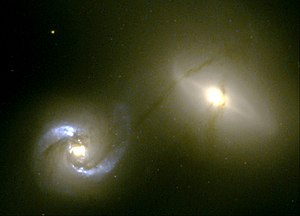NGC 1410
| Galaxie NGC 1410 | |
|---|---|
 | |
| NGC 1409 (rechts) und NGC 1410 (links) aufgenommen vom Hubble-Weltraumteleskop | |
| AladinLite | |
| Sternbild | Stier |
| Position Äquinoktium: J2000.0, Epoche: J2000.0 | |
| Rektaszension | 03h 41m 10,7s [1] |
| Deklination | −01° 17′ 56″ [1] |
| Erscheinungsbild | |
| Morphologischer Typ | E-S0 pec[1] |
| Helligkeit (visuell) | 14,0 mag[2] |
| Helligkeit (B-Band) | 15,0 mag[2] |
| Winkelausdehnung | 0,7′ × 0,6′[2] |
| Positionswinkel | 120°[2] |
| Flächenhelligkeit | 13,1 mag/arcmin²[2] |
| Physikalische Daten | |
| Rotverschiebung | 0.025324 ± 0.000013[1] |
| Radialgeschwindigkeit | (7592 ± 4) km/s[1] |
| Hubbledistanz H0 = 73 km/(s • Mpc) | (338 ± 23) · 106 Lj (103,5 ± 7,2) Mpc [1] |
| Durchmesser | 70.000 Lj[3] |
| Geschichte | |
| Entdeckung | R. J. Mitchell |
| Entdeckungsdatum | 17. Januar 1855 |
| Katalogbezeichnungen | |
| NGC 1410 • UGC 2821 NED02 • PGC 13556 • CGCG 391-028 NED02 • MCG +00-10-012 • VV 729b • GC 754 • KPG 93B • Teil von III Zw 55 | |
NGC 1410 ist eine linsenförmige Galaxie vom Hubble-Typ SB0 im Sternbild Stier, welche 338 Millionen Lichtjahre von der Milchstraße entfernt ist.
Das Objekt wurde am 17. Januar 1855 vom irischen Astronomen R. J. Mitchell, einem Assistenten von William Parsons, mithilfe seines 72-Zoll-Teleskops entdeckt.[4]
Weblinks
- Wechselwirkende Galaxien
- goBlack
- NGC 1410/1409: Intergalactic Pipeline – Astronomy Picture of the Day vom 12. Januar 2001 (englisch).
- Mass Transfer in the Galaxy Pair NGC 1409/10
- SIMBAD Astronomical Database
- CDS Portal
Einzelnachweise
Auf dieser Seite verwendete Medien
This visible-light picture, taken by NASA's Hubble Space Telescope, reveals an intergalactic "pipeline" of material flowing between two battered galaxies that bumped into each other about 100 million years ago.
The pipeline (the dark string of matter) begins in NGC 1410 (the galaxy at left), crosses over 20,000 light-years of intergalactic space, and wraps around NGC 1409 (the companion galaxy at right) like a ribbon around a package.
Although astronomers have taken many stunning pictures of galaxies slamming into each other, this image represents the clearest view of how some interacting galaxies dump material onto their companions. These results have been presented at the 197th meeting of the American Astronomical Society in San Diego, CA.
Astronomers used the Space Telescope Imaging Spectrograph to confirm that the pipeline is a continuous string of material linking both galaxies.
Scientists believe that the tussle between these compact galaxies somehow created the pipeline, but they're not certain why NGC 1409 was the one to begin gravitationally siphoning material from its partner. And they don't know where the pipeline begins in NGC 1410. More perplexing to astronomers is that NGC 1409 is seemingly unaware that it is gobbling up a steady flow of material. A stream of matter funneling into the galaxy should have fueled a spate of star birth. But astronomers don't see it. They speculate that the gas flowing into NGC 1409 is too hot to gravitationally collapse and form stars.
Astronomers also believe that the pipeline itself may contribute to the star-forming draught. The pipeline, a pencil-thin, 500 light-year-wide string of material, is moving a mere 0.02 solar masses of matter a year.
Astronomers estimate that NGC 1409 has consumed only about a million solar masses of gas and dust, which is not enough material to spawn some of the star-forming regions seen in our Milky Way. The low amount means that there may not be enough material to ignite star birth in NGC 1409, either.
The glancing blow between the galaxies was enough, however, to toss stars deep into space and ignite a rash of star birth in NGC 1410. The arms of NGC 1410, an active, gas-rich spiral galaxy classified as a Seyfert, are awash in blue, the signature color of star-forming regions. The bar of material bisecting the center of NGC 1409 also is a typical byproduct of galaxy collisions.
Astronomers expect more fireworks to come. The galaxies are doomed to continue their game of "bumper cars," hitting each other and moving apart several times until finally merging in another 200 million years. The galaxies' centers are only 23,000 light-years apart, which is slightly less than Earth's distance from the center of the Milky Way. They are bound together by gravity, orbiting each other at 670,000 miles an hour (1 million kilometers an hour). The galaxies reside about 300 million light-years from Earth in the constellation Taurus.